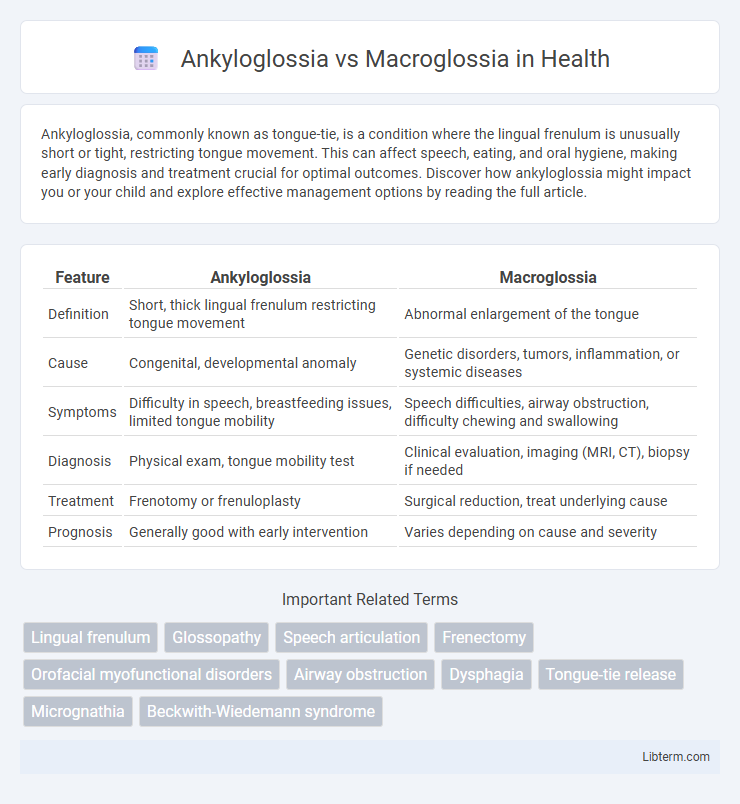Ankyloglossia, commonly known as tongue-tie, is a condition where the lingual frenulum is unusually short or tight, restricting tongue movement. This can affect speech, eating, and oral hygiene, making early diagnosis and treatment crucial for optimal outcomes. Discover how ankyloglossia might impact you or your child and explore effective management options by reading the full article.
Table of Comparison
| Feature | Ankyloglossia | Macroglossia |
|---|---|---|
| Definition | Short, thick lingual frenulum restricting tongue movement | Abnormal enlargement of the tongue |
| Cause | Congenital, developmental anomaly | Genetic disorders, tumors, inflammation, or systemic diseases |
| Symptoms | Difficulty in speech, breastfeeding issues, limited tongue mobility | Speech difficulties, airway obstruction, difficulty chewing and swallowing |
| Diagnosis | Physical exam, tongue mobility test | Clinical evaluation, imaging (MRI, CT), biopsy if needed |
| Treatment | Frenotomy or frenuloplasty | Surgical reduction, treat underlying cause |
| Prognosis | Generally good with early intervention | Varies depending on cause and severity |
Introduction to Tongue Disorders
Tongue disorders such as ankyloglossia and macroglossia significantly impact oral function, speech, and overall oral health. Ankyloglossia, commonly known as tongue-tie, is characterized by an abnormally short lingual frenulum restricting tongue movement, whereas macroglossia involves an enlarged tongue that can cause obstruction and articulation difficulties. Understanding these conditions aids early diagnosis and tailored treatment to improve feeding, speech development, and quality of life.
Understanding Ankyloglossia (Tongue-Tie)
Ankyloglossia, commonly known as tongue-tie, is a congenital condition characterized by an unusually short or tight lingual frenulum, restricting tongue movement and impacting speech, feeding, and oral hygiene. This contrasts with macroglossia, which involves an abnormally large tongue that can cause airway obstruction, dental malocclusions, and speech difficulties. Early diagnosis and treatment of ankyloglossia, including frenotomy or frenuloplasty, are crucial for improving tongue function and preventing complications.
Overview of Macroglossia (Enlarged Tongue)
Macroglossia is a condition characterized by an abnormally enlarged tongue, which can lead to difficulties in speech, eating, and breathing. It is often associated with congenital disorders such as Down syndrome, Beckwith-Wiedemann syndrome, and vascular malformations, or can result from acquired causes like tumors, infections, or trauma. Diagnosis involves clinical examination and imaging, while treatment varies from conservative management to surgical reduction based on severity and functional impairment.
Key Differences Between Ankyloglossia and Macroglossia
Ankyloglossia, commonly known as tongue-tie, is characterized by a shortened lingual frenulum that restricts tongue movement, impacting speech and feeding. Macroglossia involves an abnormally large tongue, often associated with conditions like Down syndrome or hypothyroidism, leading to difficulties in swallowing, speaking, and malocclusion. Key differences include the underlying cause--frenulum abnormality in ankyloglossia versus tongue hypertrophy in macroglossia--and their distinct clinical presentations and treatment approaches.
Causes and Risk Factors
Ankyloglossia, commonly known as tongue-tie, is caused by a short or tight lingual frenulum restricting tongue movement, often resulting from congenital developmental anomalies during embryogenesis. Macroglossia, characterized by an abnormally large tongue, can stem from genetic conditions such as Down syndrome, hypothyroidism, or vascular malformations like hemangiomas. Both conditions pose risks for feeding difficulties, speech impairment, and oral hygiene challenges, with ankyloglossia linked to familial history and premature birth, while macroglossia risk factors include prenatal infections and metabolic disorders.
Symptoms and Clinical Presentation
Ankyloglossia presents with restricted tongue mobility due to a short lingual frenulum, leading to difficulties in breastfeeding, speech articulation, and oral hygiene. Macroglossia is characterized by an enlarged tongue, causing airway obstruction, speech difficulties, and dental malocclusions. Both conditions require clinical evaluation to differentiate based on the presence of tongue restriction versus increased tongue size and related functional impairments.
Diagnostic Methods
Ankyloglossia diagnosis primarily relies on clinical assessment of tongue mobility, including the evaluation of the lingual frenulum's length and elasticity using tools like the Hazelbaker Assessment Tool for Lingual Frenulum Function (HATLFF). Macroglossia diagnosis involves physical examination of tongue size relative to oral cavity, supplemented by imaging techniques such as MRI or CT scans to identify tissue hypertrophy or associated structural abnormalities. Both conditions may require a multidisciplinary approach combining clinical, radiological, and functional assessments to guide appropriate management.
Treatment Strategies for Both Conditions
Treatment strategies for ankyloglossia primarily involve frenectomy or frenuloplasty to release the tongue's restricted movement and improve speech or feeding issues. Macroglossia management ranges from conservative approaches, such as speech therapy and orthodontic treatment, to surgical reduction glossectomy in severe cases causing functional impairment or airway obstruction. Both conditions require interdisciplinary evaluation by specialists including speech therapists, oral surgeons, and pediatricians to tailor individualized care plans.
Complications and Long-Term Outcomes
Ankyloglossia, characterized by a restricted lingual frenulum, can lead to speech difficulties, breastfeeding challenges, and dental malocclusions if untreated, often improving with early intervention. Macroglossia involves an abnormally large tongue causing airway obstruction, dysphagia, and distinctive facial growth patterns, frequently requiring surgical correction for functional and aesthetic restoration. Long-term outcomes for ankyloglossia typically show minimal impact post-treatment, whereas macroglossia may result in persistent airway and orthodontic issues without timely management.
Prognosis and Quality of Life Considerations
Ankyloglossia prognosis is generally positive with early intervention, significantly improving speech, feeding, and oral hygiene, thus enhancing overall quality of life. Macroglossia prognosis varies depending on the underlying cause but often requires multidisciplinary management to address airway obstruction, speech difficulties, and dental malocclusions that impact daily functions. Quality of life considerations for both conditions emphasize timely diagnosis, tailored treatment plans, and long-term follow-up to prevent complications and support optimal functional outcomes.
Ankyloglossia Infographic

 libterm.com
libterm.com